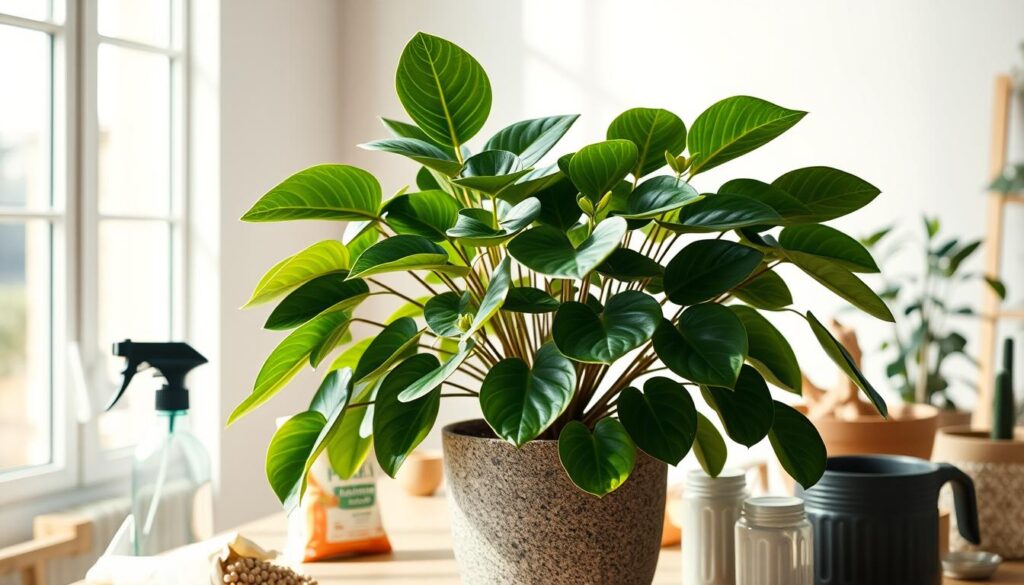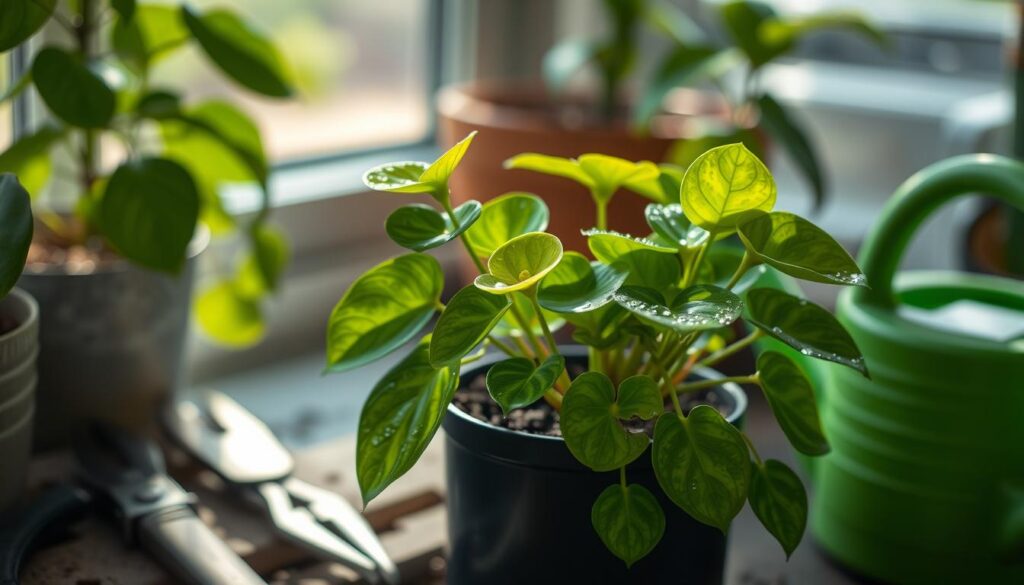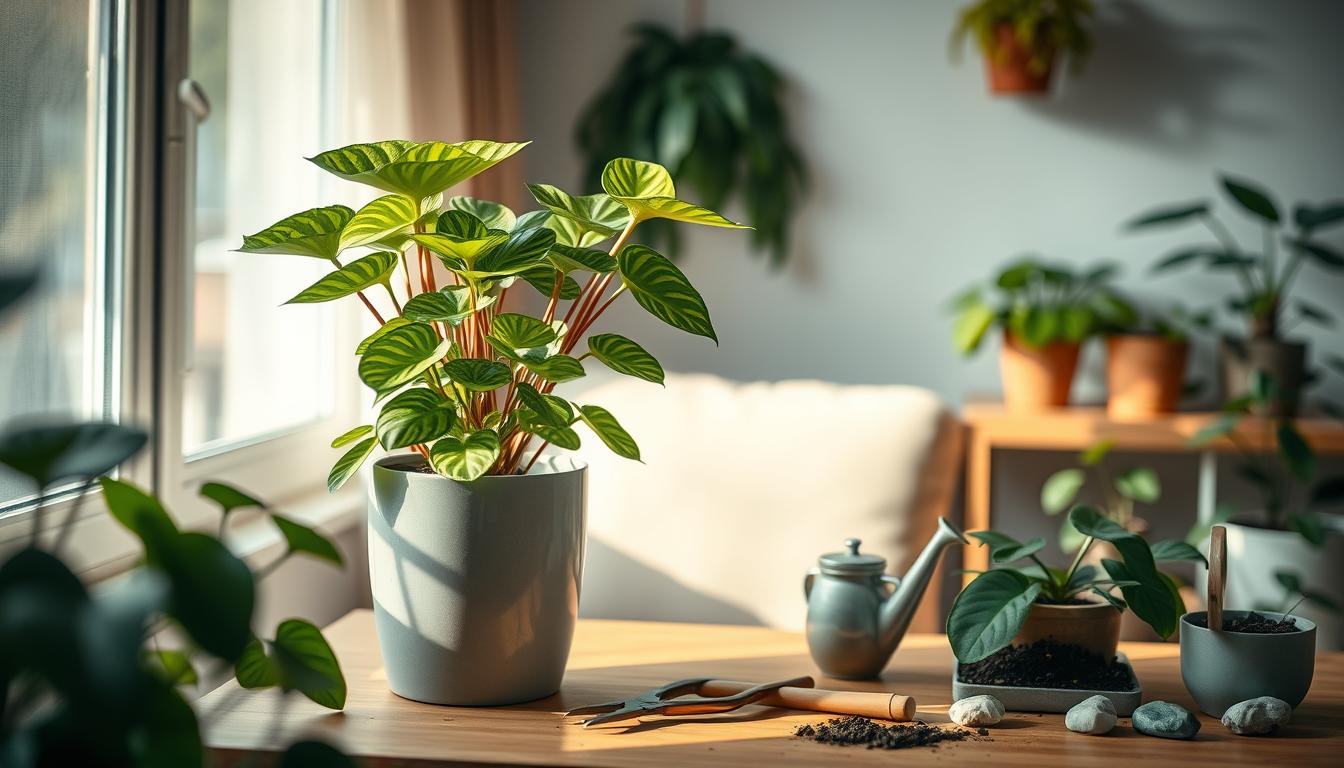Looking for houseplants that are safe for pets? Peperomia care is easy, and these plants are safe for pets. They are small, easy to care for, and look great. They’re perfect for adding green to your home.
Learning to care for peperomia is simple. These plants have been loved since the 1930s. They’re great for beginners and experts alike.
Peperomia plants are small and beautiful. They do well in medium to bright light. They’re great for cleaning the air and making your space look natural. With the right care, you’ll enjoy having them around.
Introduction to Peperomia
When you look into houseplants, you might see the Peperomia genus. It has over 1,000 species. These plants live in Central and South America. They grow well indoors because they are semi-succulents.
Overview of the Peperomia Plant
Peperomia plants have pretty leaves and grow small. They are safe for people and pets. To keep your Peperomia happy, give it bright light and water it when the soil is dry.
Benefits of Having Peperomia as a Houseplant
Peperomia plants are good for your home. They are easy to take care of. They make your air cleaner and your space prettier.
- Purifying the air and improving indoor air quality
- Adding a touch of natural beauty to your space
- Providing a sense of calm and well-being
Choosing the Right Peperomia Varieties
There are many Peperomia plants to pick from. Each one has its own special look and needs. Knowing the peperomia care instructions for your plant is key. With over 1,500 species, Peperomias come in many colors like green, white, and pink.
Popular Peperomias include the Watermelon Peperomia and the Ripple Peperomia. The Watermelon Peperomia has green and white stripes. The Ripple Peperomia has leaves that look like ripples. Taking good care of your Peperomia will make it happy and beautiful.
Here are some popular Peperomia varieties to consider:
- Peperomia Marble: features marbled patterns of green, cream, and yellow on its leaves
- Watermelon Peperomia: grows to about 8 inches tall, suitable for tight spaces
- Red Ripple Peperomia: has deep-red and purple heart-shaped leaves with a “rippled” texture
Choosing the right Peperomia and following peperomia care instructions will let you enjoy these plants. Make sure to learn what your Peperomia needs. This way, you can give it the best care practices for peperomia and watch it grow.
| Peperomia Variety | Description | Care Requirements |
|---|---|---|
| Peperomia Marble | Features marbled patterns of green, cream, and yellow on its leaves | Bright, indirect light; water sparingly |
| Watermelon Peperomia | Grows to about 8 inches tall, suitable for tight spaces | Medium to bright light; maintain high humidity |
| Red Ripple Peperomia | Has deep-red and purple heart-shaped leaves with a “rippled” texture | Low to medium light; fertilize sparingly |
Ideal Growing Conditions for Peperomia
To give the best peperomia care tips, knowing the right growing conditions is key. Peperomia plants need the right light, temperature, and humidity. They like medium to bright indirect light.
Putting them near an east- or west-facing window is best. This gives them the perfect indirect light.
Temperature is also very important. Peperomia plants do well in temperatures between 65°F to 75°F. Keep them away from heating and cooling vents to keep the temperature stable.
Humidity levels matter too. Peperomia plants like average humidity. You can put them in a terrarium or a bathroom for better humidity.
- Light: Medium to bright indirect light
- Temperature: 65°F to 75°F
- Humidity: Average humidity levels
By following these tips, you can make a great home for your peperomia plants. Always check what your specific peperomia variety needs. Some might need more or less care.
| Factor | Ideal Condition |
|---|---|
| Light | Medium to bright indirect light |
| Temperature | 65°F to 75°F |
| Humidity | Average humidity levels |
Soil and Potting Needs for Peperomia
When caring for peperomia, soil and potting are key. Peperomias like soil that drains well to avoid soggy roots. Pick a pot that’s just a bit bigger than the roots. This lets the plant grow without getting too wet.
Best Soil Mix for Peperomia
A good potting mix is crucial for peperomia plant care. You can make your own mix. Use potting soil, coco coir, orchid bark, or perlite. Try mixing 50% potting soil with 50% succulent & cactus mix or coco coir.
Choosing the Right Pot
Choosing the right pot is important. Pick one that’s only a little bigger than the plant’s current home. A too-big pot can make the soil too wet. Peperomias like their space a bit tight.
Watering Peperomia Plants
Watering is key for peperomia care. To keep your peperomia plant happy, know when to water it. Water it every 1-2 weeks, letting the soil dry out first. Lighter places need more water, darker places need less.
A peperomia plant care guide suggests checking soil moisture. Stick your finger into the soil up to the first knuckle. If it’s dry, it’s time to water. You can also use a soil probe to check moisture at the bottom.
- Droopy leaves mean your plant needs water.
- Yellow leaves can mean too much water.
- Wilting means your plant needs more water.
By following these tips, you’ll learn to care for your peperomia. You’ll give it the best peperomia care.
| Watering Frequency | Light Conditions |
|---|---|
| Every 1-2 weeks | Medium to bright indirect light |
| Less frequently | Low indirect light |
Fertilizing Your Peperomia
To keep your Peperomia happy, it needs the right food. Fertilizing is key in peperomia care. Do it in the spring and summer when it grows the most.
Use a balanced fertilizer with a 3-1-2 NPK ratio. This helps your plant grow well. Espoma Organic Indoor and FoxFarm Grow Big are good choices.
When and How to Fertilize
Fertilize your Peperomia every two weeks in the growing season. Use Indoor Plant Food, which is safe with every watering. Dilute it to half strength to avoid harming the roots.
Recommended Fertilizer Types
When picking a fertilizer, remember these tips:
- Stay away from slow-release fertilizers. They’re hard to control.
- Liquid fertilizers are better. They let you control how much you give.
- Look for a balanced fertilizer. A 2-2-2 or 6-4-4 ratio is good for Peperomia.

Follow these tips and use the right fertilizer. Your Peperomia will stay healthy. Don’t fertilize in the fall and winter when it sleeps.
Repotting Peperomia
As you care for your peperomia, you’ll need to repot it soon. This keeps your plant healthy and strong. Move it to a bigger pot with new soil when it outgrows its home. This lets the roots spread and stops the soil from getting too wet.
Look for signs like slow growth, yellow leaves, or roots showing outside. Repotting helps your plant fight off pests and sickness. Do this every 2-3 years, using a pot just a bit bigger than before.
Steps for Successfully Repotting
To repot right, follow these steps:
- Choose a pot that’s only a little bigger, with holes for water to drain.
- Use a mix that drains well, like local soil and coco fiber, to hold water better.
- Carefully take the plant out of its old pot, being gentle with the roots.
- Put the plant in the new pot, adding fresh mix around the roots.
By following these steps, your peperomia will stay happy and healthy. Always remember to care for it well, including repotting, to keep it thriving.
Pest Control and Issues
Keeping your peperomia plant pest-free is key. These plants usually don’t get many pests. But, spider mites, mealybugs, and scale can still be a problem. It’s important to check your plant often to stop pests before they start.
Some pests that might bother your peperomia include:
- Spider mites: These pests can cause yellowing leaves and fine webbing on the plant.
- Mealybugs: These pests can cause white, cottony patches on the plant.
- Scale: These pests can cause brown or black spots on the plant.
To avoid pests, keep your plant clean and happy. Water it only when the soil is dry. Make sure it gets enough light and food. These steps can help keep your plant pest-free and healthy.
For a full guide on caring for your peperomia, remember to watch out for pests. Taking steps to prevent them is important. This way, you can enjoy a healthy and beautiful peperomia plant.
| Pest | Symptoms | Treatment |
|---|---|---|
| Spider Mites | Yellowing leaves, fine webbing | Insecticidal soap or neem oil |
| Mealybugs | White, cottony patches | Rubbing alcohol or neem oil |
| Scale | Brown or black spots | Scraping and neem or horticultural oil |
Pruning and Maintenance Tips
Pruning is key to keeping your Peperomia healthy and looking good. It helps your plant grow well. You can prune your Peperomia with simple tools and some knowledge.
Use clean, sharp tools to avoid spreading diseases. Cut just above a leaf node for new growth. Prune to shape your plant, remove long stems, and make it bushy. Here are some pruning tips:
- Remove dead or damaged leaves or stems to prevent disease.
- Cut back long stems to make your plant fuller.
- Prune often to keep your Peperomia the right size and shape.
Follow these tips to keep your Peperomia happy and healthy. Prune in spring and summer when it’s growing. Don’t prune in fall and winter when it’s sleeping.

| Pruning Technique | Purpose |
|---|---|
| Removing dead or damaged leaves | To prevent the spread of disease |
| Cutting back leggy stems | To encourage branching and promote a fuller plant |
| Pruning regularly | To maintain shape and size |
Propagating Peperomia
Propagating peperomia is super fun. It’s a great way to share these beautiful plants with others. First, pick healthy leaves or stems without damage or disease.
Experts say you can use stem and leaf cuttings to propagate peperomia. Spring and summer are the best times because the plants grow faster. Make sure the conditions are right, like high humidity and warm temperatures.
Here are some best care practices for peperomia to remember when you propagate:
- Use a well-draining potting mix to prevent waterlogged soil.
- Keep the soil consistently moist but not waterlogged.
- Provide bright, indirect light to promote healthy growth.
Follow these tips and give your peperomia the right conditions. This way, you can enjoy these stunning plants. Be patient, as it takes time. And don’t worry if you have questions, just ask an expert.
Troubleshooting Peperomia Problems
When you care for your peperomia plant, you might face some common issues. Knowing the causes and solutions is key. For example, leaf discoloration can happen from too much or too little water. This is a big part of peperomia care. Changing how often you water can fix this.
Stunted growth is another problem. It might be because of not enough light or nutrients. To help your peperomia grow well, make sure it gets enough light. Also, fertilize it often, as suggested in a peperomia plant care guide. Fertilize your peperomia once a month in spring and summer.
- Check the soil moisture: Avoid overwatering, which can lead to root rot.
- Provide adequate light: Peperomia plants prefer bright, indirect light.
- Maintain optimal temperatures: Keep your peperomia plant in an area with a consistent temperature between 65°F to 80°F (18°C to 27°C).
By using these tips and knowing about common issues, you can give your peperomia the best peperomia care. This way, you can enjoy its beautiful, thriving leaves.
Conclusion: Loving Your Peperomia
Caring for a Peperomia plant is very rewarding. It brings natural beauty and peace to your home. By following the right care tips, your Peperomia will thrive and become a dear friend.
Every Peperomia is different. So, be patient and watchful as you learn what it needs. With the right light, water, and food, your Peperomia will grow well. It might even bloom flowers for you.
Peperomias are great for both new and experienced plant lovers. They bring happiness and a feeling of pride. Enjoy the journey of learning what makes your Peperomia happy. Watch it grow and flourish.





Pingback: The Ultimate Beginner's Guide to the Most Wanted Indoor Plant for 2025 - Trusted House Plant Guide